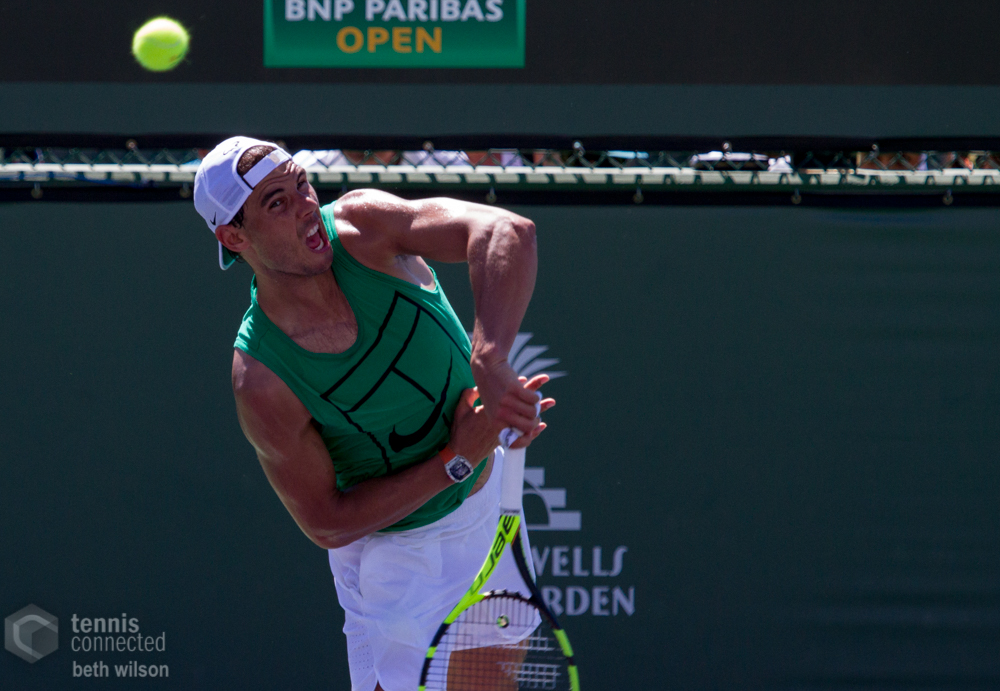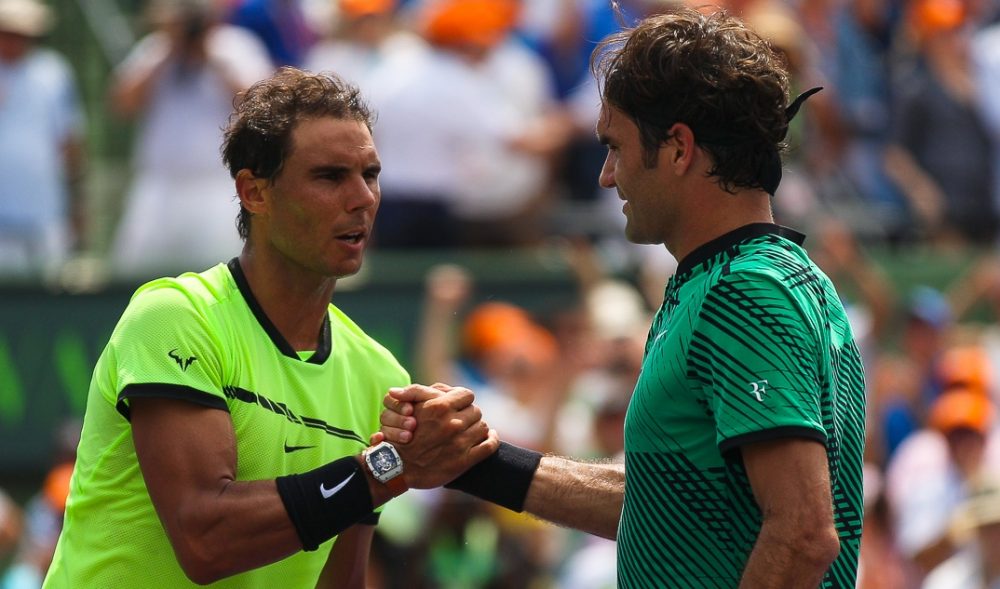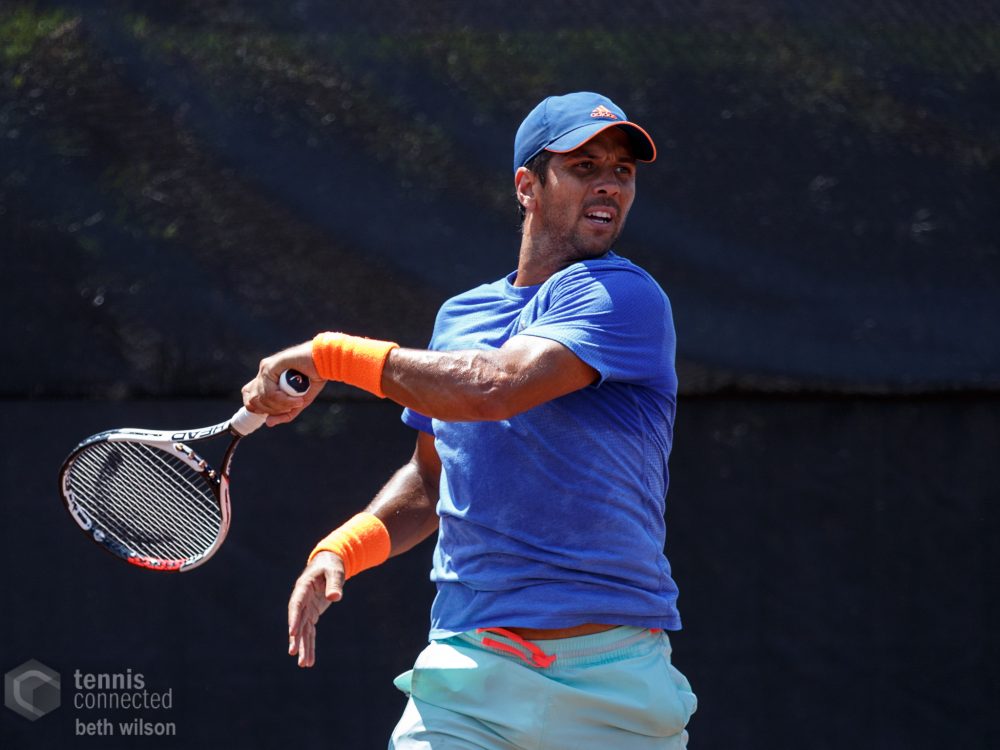The first quarter of 2017 has been a bittersweet one for Rafael Nadal.
He has had his best sustained run on hard courts since 2013. He reached the finals of the Australian Open and the Miami Open for the first time in three years. He compiled a 19-5 record and moved up to No. 5 in the rankings and No. 2 in the Race to London. And he did it all at 30 years old. Under normal circumstances, we would likely be inundated with stories about “Rafa’s renaissance,” and the wonders that his new coaching relationship with Carlos Moya has worked.
So far, though, 2017 hasn’t been about normal circumstances on the men’s tour. As it stands now, Nadal’s strong play over the last three months has had the paradoxical effect, from an historical perspective, of leaving him slightly diminished. That’s because he has lost all three of his meetings with his lifelong rival Roger Federer. Nadal came into this season with a 23-11 record against Federer; for 12 years, it had been a given that he had the upper hand in their Hall-of-Fame matchup. And there was no reason, when 2017 began, to think that a 35-year-old Federer, who was coming off a six-month layoff after knee surgery, was going to turn that around.

But turn it around he has. Federer has remade his one-handed backhand into an offensive weapon, and thus eliminated his biggest vulnerability against Rafa. In the past, Nadal could hit a heavy forehand into that side and expect a weak reply; now Federer sends the ball back with interest. That simple change has led to a wholesale role-reversal between the two men.
For 12 years, Nadal knew exactly what he needed to do against Federer, while Federer was left grasping for an effective tactic against Rafa. Now, with Nadal’s longtime go-to play taken away from him, it’s the Spaniard who is searching—so far in vain—for a new way to attack the Swiss. Federer still trails in their head to head 23-14, but he has taken the lead against Rafa on hard courts 10-9. And for the first time, Federer is riding a four-match win streak against Nadal.
Federer and his supporters have, naturally, been elated by this surprising late-career development. But as Nadal gets set to slide onto his favorite surface, clay, and into one of his favorite tournaments, in Monte Carlo, the Rafanatics of the world shouldn’t despair. Looked at with some perspective, Nadal’s own 2017 has been a pleasant surprise of its own. After two years of fighting to find his game and confidence, he’s reaching finals and beating Top 10 opponents on hard courts again. More important, he’s holding onto leads against players he should beat, something that he struggled mightily to do in 2015 and 2016.
Aside from their head-to-head record, Federer’s surge itself is good news for Nadal, and anyone who has been worried about his form in recent years. If Federer can do what he’s doing at 35, why can’t Nadal pull off something similar at 30, or 31, or 33? Over the last decade, the time frame for how long the pros can remain competitive has been extended, but Federer’s play this year (along with Serena and Venus Williams’ success on the women’s side) has destroyed that time frame entirely.

Just last year, it seemed that 29 was the age when great men’s champions began their declines. It happened to Federer and Nadal at that age, and it appeared to be happening to Novak Djokovic soon after he turned 29 in 2016. Now Federer has shown that for champions in this era, declines can be temporary, even well into their 30s. Earlier this season, Nadal mentioned that he was planning to play for many more years. Before 2017, that might have sounded like a fantasy; now there’s no reason to doubt that he can do it, and no reason to doubt that he could end up with as many as 12 French Open titles.
That said, none of this means Nadal is going to follow in Federer’s early-season footsteps, or dominate the clay season in 2017 the way he did in 2007. The days when he would rack up three Masters titles on his way to a waltz through Paris are over. With the return of Novak Djokovic and Andy Murray from injury this spring, the ATP is going to be as deep as it has ever been; for the first time that I can remember, players from ages 35 all the way to 19 will be in contention. Nadal will have have to fend off stiff challenges from Djokovic, Murray, Stan Wawrinka, Nick Kyrgios, Kei Nishikori, Dominic Thiem, Grigor Dimitrov, David Goffin, Jack Sock, and Alexander Zverev, among others. The one piece of good news for Nadal is that he won’t have to face Federer, who says he’s not planning to play again until Paris.
More than anything else, Roger’s late-career renaissance should make Rafa’s fans a little less distressed when he does lose. Not every defeat, we know now, is a sign that the end is near for him. Not every defeat to a younger player signals a changing of the guard. And not every losing streak to Federer is permanent, either; Federer suffered through three separate five-match skids to Rafa, but still managed to hang in long enough to turn it around.
The best part of all of this is knowing that the rivalry between Federer and Nadal lives on, and that even after 13 years, there may be more twists and turns—and epics matches—to come. This season has reminded us that the one thing we can never do with Roger or Rafa is count them out.

















Well written. So reassuring for a Rafa fan like me.
Fernando says do some legwork for a change and tell us something we do not already know. Anyone could have written this article and it is way late anyway.
I am Fernando @ vivafernando
Hard court Rafa is the champion.I hope Rafa will win French open